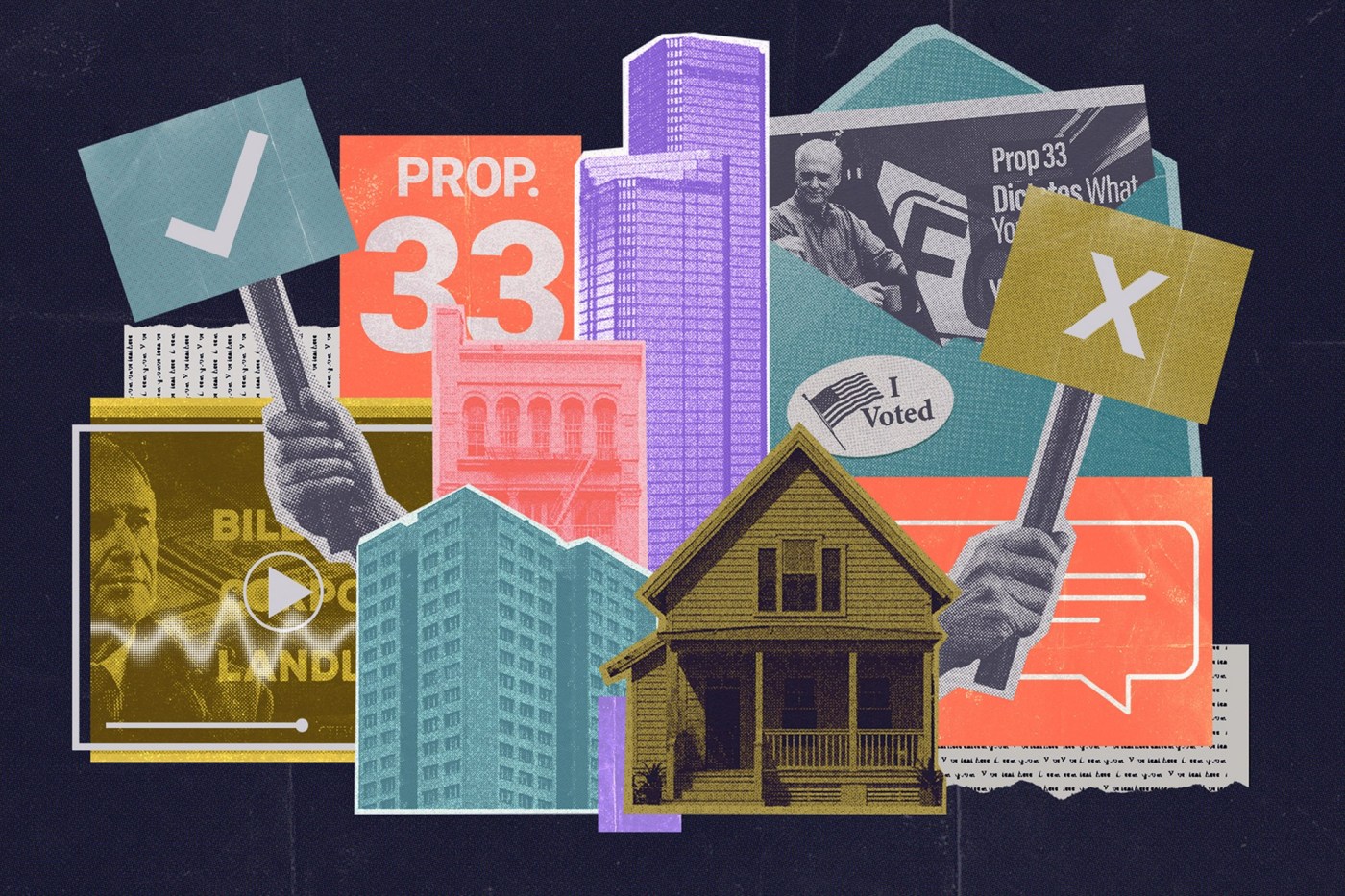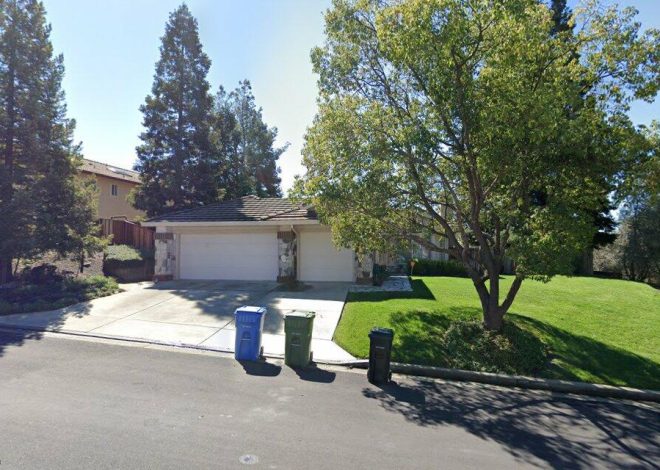
Fact-checking the ads for Proposition 33, California’s rent control ballot measure
By Felicia Mello | CalMatters
Confused about Proposition 33? You’re not alone.
A recent poll shows the ballot measure to give local governments more ability to limit rent increases is running neck and neck, with nearly a third of voters undecided.
Prop. 33 would repeal a state law known as the Costa Hawkins Rental Housing Act that prevents local governments from controlling rent on single-family homes, homes built after 1995 (or earlier in some cases), and when tenants move out. If it passes, local governments could create whatever measures they want to limit annual rent increases, and the state couldn’t intervene.
Tenant advocates largely support Prop. 33. Landlords are bankrolling the campaign against it. Democratic officials are split : Some side with tenants on the importance of keeping rents down on existing homes. Others are more focused on increasing overall housing supply, and want to make sure homes are profitable for developers to build and landlords to operate.
You wouldn’t necessarily know all this from the attack ads airing on TV and mailers fluttering into Californians’ mailboxes. Both sides say they stand for affordable housing, and some of the arguments have included a few head-scratching claims. We fact-checked some of those claims, so you don’t have to.
Claim: Prop. 33 would repeat more than 100 state housing laws, including affordable housing requirements and eviction protections.
Ken Rosen, a UC Berkeley business school professor, makes this claim in a No on 33 video ad.
Opponents of Proposition 33 argue that it would give cities who don’t want to build housing a way to undercut new development: by mandating rents so low that developers couldn’t afford to build. They say that they could make it hard to enforce recent state laws aimed at addressing the housing crisis, such as the “builder’s remedy” that relaxes zoning rules in cities whose housing plans haven’t been approved by the state.
“A city would be able to create the economic conditions to basically ignore those laws and requirements,” says Nathan Click, a spokesperson for the No on 33 campaign.
But that’s not the same as repealing those laws. And California courts have held that rent control policies are unconstitutional if they don’t allow landlords to earn “a fair and return on their property” — meaning any city that tries to force reasonable landlords to charge obviously unfeasible rents, such as $1 per month , could face legal challenges.
Verdict: False
Claim: Prop. 33 could create over 500 local rent boards
A No on 33 mailer makes this claim, pointing out that the rent boards would have the “power to regulate single-family homes, add fees to housing, and even dictate what you can charge to rent out your own home.”
There are just under 500 cities in California, and all of them could theoretically create rent boards to regulate local rents, whether or not Prop. 33 passes.
Under Prop. 33, those boards would be able to cap rent increases on single-family homes, potentially affecting income for both corporate and mom-and-pop landlords.
Rent boards can charge landlords fees to cover their operating costs — in San Francisco, for example, it’s $59 per unit — but current law already allows them to do that and would not change under Prop. 33.
Verdict: Mostly true.
Claim: ‘Rent control is an American tradition for over 100 years.’
This, from a Yes on 33 video featuring actor Blair Underwood, is pretty accurate.
“Fair rent” committees sprang up in dozens of United States cities in the early 1920s, and rent control became popular during World War II, helping drive an increase in homeownership.
However, more than 30 states have since passed laws banning local rent control. In the states that do allow some form of rent regulation — including California and New York — more than 200 local governments have passed measures limiting how much landlords can charge, according to the National Apartment Association.
Verdict: Mostly true.
Supporters of Proposition 33, a statewide California rent control ballot measure, brought their high energy ‘Yes on 33’ campaign to paradegoers during San Diego’s annual Pride Parade on Saturday, July 20, 2024 in San Diego. Californians will have opportunity to vote for rent control expansion in the state on the Nov. 5, 2024, ballot. (Christy Radecic/AP Content Services for AIDS Healthcare Foundation)
Claim: Prop. 33 would replicate the strongest rent control law in the nation
Related Articles
PRO/CON: Should California raise the minimum wage with Proposition 32?
Opinion: Many workers can’t ask for more pay. Let voters speak for them
Opinion: Raising minimum wage won’t make California any more affordable
Proposition 3: Californians will decide whether to enshrine marriage equality in the state constitution
California’s rent control ballot measure could reverberate across the US
No on 33 campaign ads make this claim, saying the proposition would erase California’s “progress on housing” by getting rid of a law signed by Gov. Gavin Newsom.
Newsom signed a law in 2019 that caps rent increases in California at 5% plus the rate of inflation, or a maximum of 10%. (The No campaign, staffed by Click, the governor’s longtime adviser, lists Newsom as an endorser.)
Prop. 33 doesn’t repeat this law, which is set to expire in 2030. It would, however, add this sentence to state law: “The state may not limit the right of any city, county, or city and county to maintain, enact, or expand residential rent control.”
Proponents say cities need this flexibility to keep annual rent increases below 10%, a rate they say still puts a big burden on tenants.
Opponents argue that cities could also use this freedom to allow rents to rise higher than the state cap.
But legal experts disagree about whether Prop. 33 might actually allow that: Deepika Sharma, housing clinic director at the University of Southern California’s Gould School of Law, said the rent cap “is not preempted by overturning Costa Hawkins,” while UC Davis law professor Chris Elmendorf said the proposition could create “a lot of legal murk about how conflicts would be resolved.”
Verdict: Mostly false.
Claim: ‘Stanford and UC experts agree Prop.33 will make the housing crisis worse’
This claim comes from a No on 33 audio ad.
Ken Rosen, the chair of UC Berkeley’s Fisher Center for Real Estate and Urban Economics, appears in a No on 33 ad and has argued that Costa Hawkins needs to be preserved or construction will slow and landlords will pull rental units off the market. This echo is the view of many economists at California’s elite universities and elsewhere that rent control reduces rental supply, a view that’s backed by some empirical studies.
But other economics and policy researchers — particularly those who believe in a stronger role for government in solving social problems — see rent control as part of the solution to housing insecurity.
“Rent regulations support those who need it most, including those who are not being adequately and safely served by the current set of regulations that provide landlords substantial market power in the housing market,” wrote 32 economists from universities including UC Santa Barbara last year, urging the Biden administration to regulate rents in buildings with federally backed mortgages.
Verdict: Somewhat misleading.
Claim: ‘Prop. 33 (eliminates) existing protections for seniors and veterans’
This claim from a No on 33 video ad is not true. Prop. 33 doesn’t contain any language about seniors and veterans, and the law it would repeat, Costa Hawkins, doesn’t either.
Verdict: False.
Claim: Homelessness in California is up nearly 40% since 2019
This Yes on 33 video ad overstates the crisis.
There are nearly 186,000 homeless Californians, according to a CalMatters analysis of the latest federally mandated census, up from about 151,000 in 2019. That’s an increase of about 23%.
Verdict: False.


